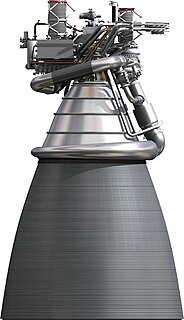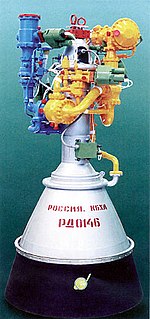
Rocketdyne was an American rocket engine design and production company headquartered in Canoga Park, in the western San Fernando Valley of suburban Los Angeles, in southern California.

MTU Aero Engines AG is a German aircraft engine manufacturer. MTU develops, manufactures and provides service support for military and civil aircraft engines. MTU Aero Engines was formerly known as MTU München.
United Technologies Corporation (UTC) is an American multinational conglomerate headquartered in Farmington, Connecticut. It researches, develops, and manufactures products in numerous areas, including aircraft engines, aerospace systems, HVAC, elevators and escalators, fire and security, building systems, and industrial products, among others. UTC is also a large military contractor, getting about 10% of its revenue from the U.S. government. Gregory J. Hayes is the CEO and chairman.

The Aerojet Rocketdyne RS-25, otherwise known as the Space Shuttle main engine (SSME), is a liquid-fuel cryogenic rocket engine that was used on NASA's Space Shuttle. NASA is planning to continue using the RS-25 on the Space Shuttle's successor, the Space Launch System (SLS).

The J-2 was a liquid-fuel cryogenic rocket engine used on NASA's Saturn IB and Saturn V launch vehicles. Built in the U.S. by Rocketdyne, the J-2 burned cryogenic liquid hydrogen (LH2) and liquid oxygen (LOX) propellants, with each engine producing 1,033.1 kN (232,250 lbf) of thrust in vacuum. The engine's preliminary design dates back to recommendations of the 1959 Silverstein Committee. Rocketdyne won approval to develop the J-2 in June 1960 and the first flight, AS-201, occurred on 26 February 1966. The J-2 underwent several minor upgrades over its operational history to improve the engine's performance, with two major upgrade programs, the de Laval nozzle-type J-2S and aerospike-type J-2T, which were cancelled after the conclusion of the Apollo program.

The RL10 is a liquid-fuel cryogenic rocket engine used on the Centaur, S-IV, and Delta Cryogenic Second Stage upper stages. Built in the United States by Aerojet Rocketdyne, the RL10 burns cryogenic liquid hydrogen and liquid oxygen propellants, with each engine producing 64.7 to 110 kN (14,545–24,729 lbf) of thrust in vacuum depending on the version in use. The RL10 was the first liquid hydrogen rocket engine to be built in the United States, and development of the engine by Marshall Space Flight Center and Pratt & Whitney began in the 1950s, with the first flight occurring in 1961. Several versions of the engine have been flown, with three, the RL10A-4-2, the RL10B-2, and the RL10C-1 still being produced and flown on the Atlas V and Delta IV.

Atlas II was a member of the Atlas family of launch vehicles, which evolved from the successful Atlas missile program of the 1950s. It was designed to launch payloads into low earth orbit, geosynchronous transfer orbit or geosynchronous orbit. Sixty-three launches of the Atlas II, IIA and IIAS models were carried out between 1991 and 2004; all sixty-three launches were successes, making the Atlas II the most reliable launch system in history. The Atlas line was continued by the Atlas III, used between 2000 and 2005, and the Atlas V which is still in use.

Hamilton Standard, an aircraft propeller parts supplier, was formed in 1929 when United Aircraft and Transport Corporation consolidated Hamilton Aero Manufacturing and Standard Steel Propeller into the Hamilton Standard Propeller Corporation. Other members of United Aircraft included Boeing, United Airlines, Sikorsky, and Pratt & Whitney. At the time, Hamilton was the largest manufacturer of aircraft propellers in the world.

Frederick Brant Rentschler was an American aircraft engine designer, aviation engineer, industrialist, and the founder of Pratt & Whitney Aircraft. Rentschler created and manufactured many revolutionary aircraft engines, including those used in the aircraft of Charles Lindbergh, Amelia Earhart and James Doolittle. He is also a co-founder of United Aircraft and Transport Corporation, the predecessor of United Technologies Corporation.

Pratt & Whitney Stadium at Rentschler Field is a stadium in East Hartford, Connecticut. It is primarily used for football and soccer, and is the home field of the University of Connecticut (UConn) Huskies. In the fall of 2010, it was home to the Hartford Colonials of the United Football League. The stadium, which opened in 2003, was the first stadium used primarily by an NCAA Division I-A team to open in the 21st century. The permanent stadium capacity is 40,000, consisting of 38,066 permanent seats with a standing-room area in the scoreboard plaza that can accommodate up to 1,934 people. It also has a game day capability to add approximately 2,000 temporary seats as it did for UConn
football vs. Michigan in 2013. Connecticut played on campus at Memorial Stadium in Storrs, before 2003.

The RS-27A is a liquid-fuel rocket engine developed in 1980s by Rocketdyne for use on the first stage of the Delta II and Delta III launch vehicles. It provides 1.05 meganewtons (240,000 lbf) of thrust burning RP-1 and LOX in a gas-generator cycle. The engine is a modified version of its predecessor, the RS-27; its thrust nozzle has been extended to increase its area ratio from 8:1 to 12:1, which provides greater efficiency at altitude. The earlier RS-27 was derived from surplus Rocketdyne H-1 engines used in the Saturn 1B launcher.

The J-2X is a liquid-fueled cryogenic rocket engine that was planned for use on the Ares rockets of NASA's Constellation program, and later the Space Launch System. Built in the United States by Aerojet Rocketdyne, the J-2X burns cryogenic liquid hydrogen and liquid oxygen propellants, with each engine producing 1,307 kN (294,000 lbf) of thrust in vacuum at a specific impulse (Isp) of 448 seconds (4.39 km/s). The engine's mass is approximately 2,470 kg, significantly heavier than its predecessors.

The RD-0146 is a Russian cryogenic rocket engine. The RD-0146 engine was developed by KBKhA design bureau in Voronezh, Russia, in cooperation with the American Pratt & Whitney Rocketdyne company. In 2009, it came into prominence, as Russian space agency chose it for the second-stage of the proposed Rus-M launch vehicle designed to carry the future Russian PPTS manned spacecraft. After the cancellation of Rus-M rocket, the RD-0146D variant is selected as the powerplant for the KVTK upperstage.
Hamilton Sundstrand was an American globally active corporation that manufactured and supported aerospace and industrial products for worldwide markets. A subsidiary of United Technologies Corporation, it was headquartered in Windsor Locks, Connecticut. The company was formed from the merger of Hamilton Standard and Sundstrand Corporation in 1999. In 2012, Hamilton Sundstrand was merged with Goodrich Corporation to form UTC Aerospace Systems.
Aerojet Rocketdyne is an American rocket and missile propulsion manufacturer. Headquartered in Sacramento, California, the company is owned by Aerojet Rocketdyne Holdings. Aerojet Rocketdyne was formed in 2013 when Aerojet and Pratt & Whitney Rocketdyne were merged, following the latter's acquisition by GenCorp from Pratt & Whitney. On April 27, 2015, the name of the holding company, GenCorp, was changed from GenCorp, Inc. to Aerojet Rocketdyne Holdings, Inc.

Aestus is a hypergolic liquid rocket engine used on an upper stage of Ariane 5 family rockets for the orbital insertion. It features unique design of 132 coaxial injection elements causing swirl mixing of the MMH propellants with Nitrogen tetroxide oxidizer. Engine allows for multiple re-ignitions.















